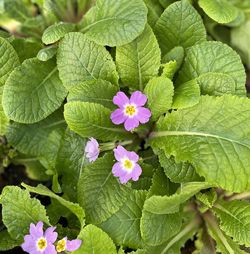Monarda
Wild Bergamot/Beebalm
This genus was named after Dr. Nicolas Monardes, a Spanish physician whose Joyfull Newes Out of the New Founde Worlde was the first book to be published about the flora of the Americas. A summer-blooming member of the Mint family, everything about this plant is intriguing. Excellent in arrangements, its jaunty whorled blossoms and decorative bracts attract butterflies and hummingbirds, while holding our interest even in winter. Lining erect and robust stems, the opposite leaves are deliciously fragrant. An engaging addition to the border or a meadow setting, Bergamot offers pleasing contrast to the more undefined forms of the garden, as well as to the linear aspect of grasses. Happiest in moist fertile soil, Monarda’s dense clump needs to be divided every 2 to 3 years. Most of the cultivars exhibit outstanding resistance to powdery mildew.
OUT OF PRODUCTION AT THIS TIME
Email me when this plant is available
A central U.S. inhabitant, this superlative small-statured Monarda champions some admirable traits: early-blooming flowers, deer and mildew resistance plus a well-behaved slow spreading habit. Short steadfast stems forge a clump characterized by spiffy aromatic grayish green foliage plus grand, dense pinkish lavender globes of purple speckled 2-lipped flowers, which reside upon violet-infused leafy bracts. Captivating bees and butterflies, the festooned flowers sustain their intrigue as they morph into dried seed heads.
Blooms May–July
Size: 12" – 2' 0" high x 12" – 2' 0" wide.
Hardy to zone 4.
Monarda x ‘Coral Reef’ (P-1661)
Each $11.50
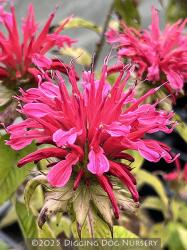
Celebrating a sassy mop of brilliant coral pink blooms, this new must-have selection comes from the Morden Breeding Program in Manitoba, Canada. ‘Coral Reef’s whorled Salvia-like flowers sport prominent green centers and green bracts, while its tidy, more compact habit is similar to ‘Marshall’s Delight’.
Slightly polished dark green foliage sets off the hot floral presentation that can be sprinkled near Penstemon ‘Blue Midnight’ and Eryngium ‘Big Blue’ for an energetic combination. (pp#16,741)
Blooms June – August.
Size: 2-1/2' – 3' 0" high x 15" wide.
Zone 3/4.
Monarda ‘Croftway Pink’ (P-2239)
Each $11.50
Reminiscent of fanciful jester hats, the large, whorled rosy-pink inflorescences promote myriad 2-lipped tubular flowers nestled upon prominent pink-suffused bracts. This classic 1932 cultivar hosts stiff vertical stems lined with aromatic lance-shaped apple-green foliage beneath the generous long-lasting hoopla that entices bees, hummingbirds and florists alike. An undemanding top-notch midborder plant, ‘Croftway Pink’ can be flanked by Stipa gigantea and Veronicastrum ‘Pink Glow’, while Aster ‘Avondale’ and Geranium ‘Rozanne’ take the lead.
Blooms July–mid September
Size: 2-1/2' – 3' 0" high x 12" – 18" wide.
Hardy to zone 4.
Monarda didyma ‘Jacob Cline’ (P-1126)
Each $11.50
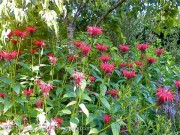
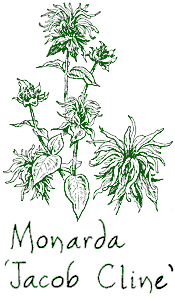
Deemed by many gardeners to be “the best red,” this showy Monarda was discovered way down south growing along Georgia’s Blue Ridge Parkway. Cloaked in vivid deep green leaves, its tall firm stems stage a blazon display of large, tufted red flowers lodged on leafy maroon bracts.
Blooms late June–September
Size: 4' 0" – 5' 0" high x 15" wide.
Zone 3/4.
Monarda ‘Fire Marshall’ (P-2065)
Each $11.50
The prodigal offspring of two top performing Beebalms, ‘Marshalls Delight’ and ‘Jacob Cline’, this Dr. Jim Ault introduction swaggers enormous shaggy flower heads stained in red and ruddy pink tones hoisted atop stout stems. Natty green foliage cloaks the medium-sized frame that is commended for its topnotch mildew resistance. A show-off beacon in sunny mixed borders, meadow plantings or prairie-style venues, ‘Fire Marshall’ galvanizes garden visitors and hummingbirds alike. (pp#23,286)
Blooms June–August
Size: 4' 0" – 3' 0" high x 15" – 2' 0" wide.
Hardy to zone 4.
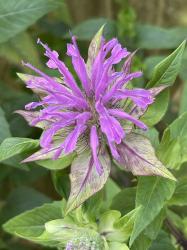
So smitten with their discovery in Tylertown, MS, Mike and Barbara Bridges named this floriferous show-stopper after their daughter. Adored by hummingbirds and butterflies, ‘Claire Grace’ presents attractive 2 to 3 in. wide pincushion-style clusters of tubular lavender-hued blooms all summer long. Sturdy upright stems are clothed with aromatic, toothed grayish green leaves, which develop a glossy luster and good mildew resistance plus concoct a flavorful tea. Her top-performing habit is reputed to abide both dry and wet conditions, while appreciating good air circulation as well as rich well-drained soil.
Blooms June–September
Size: 3' 0" – 4' 0" high x 18" – 2' 0" wide.
Hardy to zone 3.
Monarda didyma ‘Grand Marshall’ (P-1943)
Each $11.50
Developed by an agricultural breeding program in Morden, Manitoba, this exceptional new introduction volunteers plenty of large, shaggy vivid-hued fuchsia-purple blooms above a midsized highly mildew-resistant foundation. The nectar-rich, perfect-for-cutting flowers entice all sorts of pollinators, while attractive pointed dark green leaves waft a mint aroma. Best grown in fertile moisture-retentive soil, ‘Grand Marshall’ can grace a perennial border, cottage garden or meadow-like planting with Phlox and Molinia. (PP#19,582)
Blooms June–August
Size: 2' 0" – 2-1/2' high x 10" – 15" wide.
Hardy to zone 3.
Shaggy-looking, vibrantly hued and cut-flower perfect, the close-knit rosy-purple heads are subtended by ornate dusky-magenta bracts. This reliable 1955 German cultivar musters strong erect stalks plus winsome lance-like rich greenery that wafts a refreshing mint redolence. Happiest with good air flow, plenty of sun and moderate fertility, ‘Prairie Night’ makes a no-nonsense colorful companion for U.S. natives such as Aster oolentangiense, Baptisia ‘Purple Smoke’ and Liatris ligulistylis, while wowing the pollinators, yet snubbing bunnies and deer.
Blooms June–August
Size: 3-1/2' high x 18" – 2' 0" wide.
Hardy to zone 4.
OUT OF PRODUCTION AT THIS TIME
Email me when this plant is available
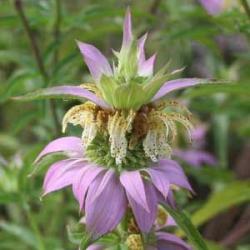
Pollinators flock by the droves to unique, painterly whorled rosettes of yellowish, purple-speckled tubular flowers and large, pointed pale mauve and pink leaf-like bracts, which adorn the dense elongated spikes. Indigenous to the eastern U.S. from Long Island to Florida, Spotted Horsemint is an upright multistemmed perennial with sturdy violet-tinged stalks and toothed, tea-worthy oblong leaves, smelling like oregano. This marvelous deer-resistant native lends showy accents to bouquets, borders and butterfly gardens, where it craves sharp-draining sandy soil plus good air circulation and generally reseeds since it may be somewhat short-lived.
Blooms June–July
Size: 18" – 2' 0" high x 9" – 12" wide.
Hardy to zone 4.
Monarda ‘Purple Rooster’ (P-1850)
Each $11.50
Selected from a patch of didyma seedlings, this lavishly hued 2009 introduction by David Nedvect of the Flower Factory reflects his fondness for roosters. ‘Purple Rooster’ clearly lives up to its name, strutting large long-blooming flowers bathed in the truest royal-purple shades imaginable. The hard-to-beat floral splendor holds court atop staunch stems that are lined with clean mildew-resistant, mint-scented foliage.
Blooms June–August
Size: 3' 0" high x 18" – 2' 0" wide.
Hardy to zone 4.
Monarda ‘Raspberry Wine’ (P-1600)
Each $11.50
Awarded top honors at a recent Chicago Botanical Garden trial that included nearly 40 Monarda varieties, ‘Raspberry Wine’ promises to be a champion in your garden as well. Its upright stand of strong leafy stems gives way to long-blooming flowers, flaunting fanciful tops, each delicately perfumed and saturated with vibrant wine-red hues.
Blooms June–August
Size: 2-1/2' – 3' 0" high x 15" wide.
Zone 3/4.
Monarda x ‘Violet Queen’ (P-1128)
OUT OF PRODUCTION AT THIS TIME
Email me when this plant is available
Crowning red-tinged bracts, this Monarda’s vivid lavender-violet flowers will reign in your garden. Its downy soft, grayish green foliage makes a pleasing, fragrant base for the colorful and curved, tubular blooms.
Blooms June – August.
Size: 2-1/2' – 3' 0" high x 15" wide.
Zone 3/4.










